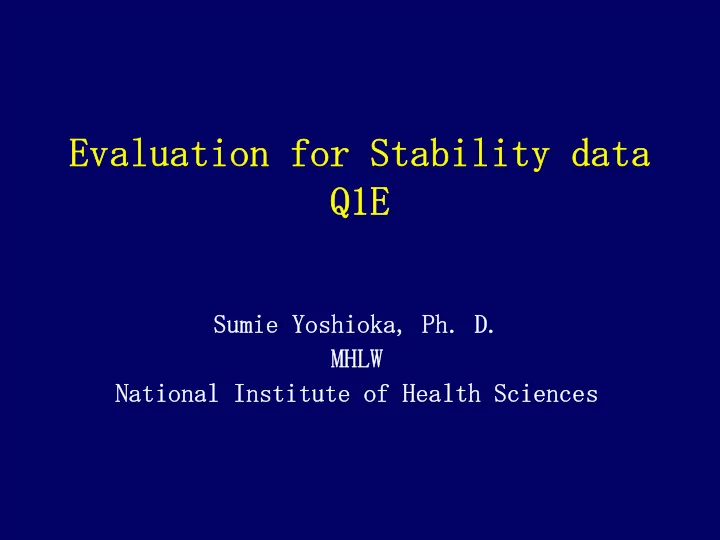

Evaluation for Stability data Q1E Sumie Yoshioka, Ph. D. MHLW National Institute of Health Sciences
Q1E provides recommendations on : � How to use stability data generated according to Q1AR � When and how a retest period or a shelf life can be extended beyond the period covered by long-term data Q1E contains examples of statistical approaches to stability data analysis
� Extrapolation toto extend retest period/shelf life � Statistical approaches recommended in the guideline
Yes Accelerated condition Significant change No
Where no significant change occurs at accelerated condition No Yes Little or no change Little or no variability Accelerated data & Long-term data
Where accelerated data show significant change No Significant Yes change Intermediate condition
Yes Statistical analysis Performed? Amenable? No
Yes Supporting data Available? No
Four outcomes passing through crossroads for Room Temperature Storage 12 month extension 6 month extension 3 month extension No extension
Outcome 1 12 month extension accelerated data show no significant change accelerated data & long-term data little or no change little or no variability Outcome 4 no extension significant change at accelerated condition at intermediate condition
Statistical analysis longer retest period/shelf life (not necessarily required)
Where � Accelerated data show no significant change � Changes and variations in accelerated data long-term data No amenable? 6 month extension performed? with Supporting data Yes 12 month extension
Where Significant change at accelerated condition but not at intermediate condition No amenable? 3 month extension performed? with Supporting data Yes 6 month extension
Statistical analysis longer retest period/shelf life not always required Where � significant change at accelerated & intermediate conditions � variability in long-term data Statistical analysis can be appropriate to verify retest period/shelf life
Statistical approaches recommended in the Appendix � How to analyze long-term data for appropriate quantitative attributes � How to use regression analysis for retest period/shelf life estimation � Examples of statistical procedures to determine poolability of data from different batches or factor combinations
Regression analysis Establish retest period/shelf life with a high degree of confidence Quantitative attribute will remain within acceptance criteria for all future batches
Shelf-life E stim ation w ith U pper and Low er A cceptance C riteria B ased on A ssay at 25C /60% R H 120 115 Assay (% of Label Claim) 110 105 R aw D ata 100 U pper confidence lim it Low er confidence lim it 95 R egression line 90 U pper acceptance criterion: 105 85 Low er acceptance 80 criterion: 95 0 3 6 9 12 15 18 21 24 27 30 33 36 39 42 45 48 Tim e Point (M onths)
Statistical approaches for determining whether data from different batches/factor combinations can be pooled � (Approach #1) Whether data from all batches/factor combinations support the proposed period � (Approach #2 “ Poolability test ” ) Whether data from all batches/factor combinations can be combined for overall estimate of a single period � (Alternative approaches)
Approaches #1 and #2 can also be applied to data analysis for multi-factor studies including Bracketing & Matrixing Designs
Basic Principles � A shelf life is set based on long-term data � The extent of extrapolation will depend on accelerated (and if applicable, intermediate) data, as well as long-term data � Supporting data are useful in predicting long-term stability in primary batches
Basic Principles (cont’d) � Statistical analysis is not always necessary for setting a shelf life � A shelf life beyond the period covered by available long-term data can be proposed with supporting data, with or without statistical analysis � Where a statistical analysis is performed, longer extrapolation can be justified
MHLW Perspective - Q1E Before Q1E EU---12 month extrapolation with or without statistical analysis; US--- max 6 month extrapolation with statistical analysis; Japan--- no practical extrapolation � Q1E provides guidance on the extent of shelf life extrapolation in a variety of situations � Q1E clearly describes the role of accelerated data and of supporting data in shelf life estimation
Recommend
More recommend